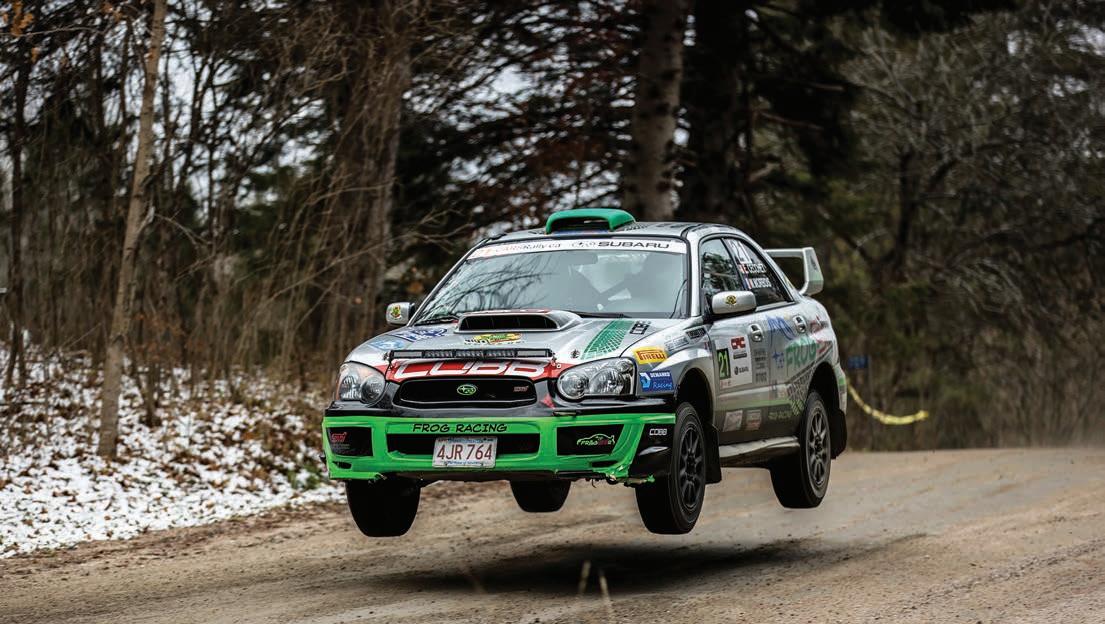
4 minute read
CRC Primer
Rally 101
GET UP TO SPEED ON THE INS AND OUTS OF RALLYSPORT

With Files From Carsrally.ca ally tests competitors to the limits of their abilities. Day, night, rain, shine or blizzard, teams face a wide range of conditions while racing on challenging roads, with a route book as their road map. The competitive portions of rallies are “special stages” run on closed forest roads, which competitors must complete as quickly as possible. Stages are linked by transit sections, where all regular rules of the road are applied. Service breaks allow time for rest, repairs and meals. Rally teams consist primarily of a driver and a co-driver. The driver has the obvious task – to drive fast. The co-driver keeps the team on time and on route, in addition to reading the notes during the stages to inform the driver of what lies ahead. The service crew also plays an important role by performing repairs and routine maintenance. Rally cars start out as regular road cars, but have extensive modifications to ensure they are safe, reliable and fast. Roll cages, safety harnesses, helmets and flame-retardant suits provide protection. Beefy suspensions soak up the bumps and jumps. Special tires offer greater traction on gravel and icy roads. Performance-enhancing modifications vary depending on the car’s class.
CAR CLASSES
There are numerous classes that accommodate a range of cars and budgets. Rally cars are grouped into categories that separate them during competition. The Production category restricts teams to very few modifications, which allows competitive, low cost competition, while the Open category allows any car with virtually no restriction. Open is where most of the flame-spitting, high horsepower monsters compete. Production and Open class cars are then placed into Two-Wheel-Drive or Four-Wheel-Drive categories depending on their drivetrain.
WANT TO GET INVOLVED?
You can volunteer. Organizers are usually looking for people to act as marshals and control workers. No experience is necessary and veteran rally marshals provide training. Volunteering at a rally is a great way to learn the inner workings of the sport. Or you can join a club. There are rally clubs in most Canadian and US cities that organize events for all skill levels and racing budgets. Often, experienced club members are happy to share advice with newcomers to the rally community.
SPECTATOR SAFETY
Since performance rallies normally take place on forest roads in wilderness areas, persons attending the Rally of the Tall Pines do so entirely at their own risk. That being said, viewing the sport of rallying can become an interesting adventure in itself. We suggest that you prepare as if you were going for a walk in the woods. Take warm clothing and footwear, a camera, a watch, food and a flashlight. By observing the noted precautions, your day at the Rally of the Tall Pines should be both memorable and enjoyable.
Competitors will be travelling over a wide geographical area throughout the day. The high-speed, timed stages are held on closed,

(Opposite page) Emmanuel Cecchet and Michael Morbois get some air at the 2021 Lincoln Electric Rally of the Tall Pines. (Above) Iron Bridge is an iconic part of the annual Lincoln Electric Rally of the Tall Pines spectating experience. Photo by Rob Sztuka
forest access roads. Organizers have set up specific spectator viewing areas along the rally route. Our spectator areas are among some of the best in North America and are the prime places to catch all of the action. Please remember that the spectator areas are on private property so please listen to the marshals, do not start campfires or litter, and help us to respect the landowners so that we may return in future years. Food vendors will be on-site at the spectator areas and will be providing hot food and beverages. Rally merchandise will also be on sale at the spectator areas. If you wish to purchase anything, please bring cash, as debit and credit are typically not accepted. Keep in mind that all local authorities and the Ontario Provincial Police are very familiar with the route of the rally. Play it safe, stick to the posted speeds and drive safely! Also note that no fires or camping are permitted at any of the spectator areas.
DRONES
The liability insurance policy for the Lincoln Electric Rally of the Tall Pines does not include coverage for the use of drones. Use of such devices and all other unmanned aircraft of any kind is strictly prohibited along any of the routes or any of the facilities used by the rally, unless previously authorized in writing by the organizers of the rally.
SAFETY TIPS

Do not camp or start a fire at any of the spectator areas. Spectator areas are monitored by the OPP. Do not stand too close to any of the roads. Do not block escape routes. Rally cars may need the runoff room and emergency vehicles need to have fast access to the road in case of an emergency. Never stand on the outside of corners. Never stand in areas marked with red prohibited area tape. Stay behind all yellow caution tape and safety fences. They’re there for a reason. Never cross the stage road. Try to keep behind something solid, such as a large tree, and leave room to move quickly. Keep children under close supervision and dogs on a leash. Please listen to the marshals’ instructions. November weather in the Bancroft area can change very quickly. Be prepared for sun, rain, snow and cold. Bring chairs and sun block depending on the weather. TP




